Supreme Court of Justice of the Nation
The Supreme Court of Justice of the Nation (Spanish: Suprema Corte de Justicia de la Nación (SCJN) is the Mexican institution serving as the country's federal high court and the spearhead organisation for the judiciary of the Mexican Federal Government. It consists of eleven magistrates, known as ministers of the court, one of whom is designated the court's president.
| Supreme Court of Justice of the Nation | |
|---|---|
| Suprema Corte de Justicia de la Nación | |
 | |
| Established | 1825 |
| Location | Pino Suárez no. 2, Colonia Centro, Delegación Cuauhtémoc, C.P. 06065, Mexico City |
| Coordinates | 19°25′52.01″N 99°7′55.58″W |
| Composition method | Supreme Court |
| Authorized by | Constitution of Mexico |
| Judge term length | 15 years |
| Number of positions | 11 |
| Website | https://www.scjn.gob.mx/ |
| President | |
| Currently | Arturo Zaldívar Lelo de Larrea |
| Since | 2 January 2019 |
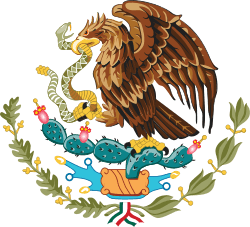 |
|---|
| This article is part of a series on the politics and government of Mexico |
|
|
|
|
|
Judges of the SCJN are appointed for 15 years.[1] They are ratified through affirmation by the Senate from a list proposed by the President of the Republic. The ministers chosen will select from among themselves who shall be the President of the Court to serve a four-year period; any given minister may serve out more than one term as president, but may not do so consecutively.
Requirements for holding a seat on the Supreme Court of Justice of the Nation
- Be a natural born citizen of Mexico.
- Be no less than 35 years of age nor over 65 years of age at the time of one's appointment
- Have held a Law degree for at least 10 years.
- To have a good reputation and have not have been convicted of theft, fraud, forgery, breach of trust, or any other offense which could imply a punishment of more than one year in prison.
- Not have been Director for Domestic Affairs, Chief of an Administrative Department, Attorney General of the Republic or Federal District Attorney, Senator, Member of Parliament, Governor of any State, or Chief Executive of the Federal District during the year prior to his or her appointment.
The Constitution requires that the appointment of ministers of the court should fall to those persons who have served ably, effectively and honorably in the administration of justice, or to those who have distinguished themselves by their honor, competence and professional background in the exercise of their duties.
Ministers may take leave of their posts for three reasons:
- The end of their terms
- Relinquishment, which is only allowed in serious cases, all of which must be affirmed by the President and accepted or discarded by the Senate.
- Voluntary retirement: Proceeds when the interested party requests their retirement, as long as they meet the conditions of age and seniority.
Supreme Court building
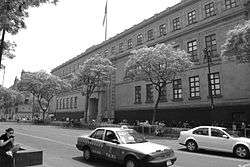
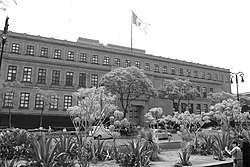
The court itself is located just off the main plaza of Mexico City on the corners of Pino Suarez and Carranza Streets. It was built between 1935 and 1941 by Antonio Muñoz Garcia. Prior to the Conquest, this site was reserved for the ritual known as "Dance of the Flyers" which is still practiced today in Papantla. Hernán Cortés claimed the property after the Conquest and its ownership was in dispute during much of the colonial period with Cortes' heirs, the city government, and the Royal and Pontifical University all claiming rights. It was also the site of a very large market known as El Volador.[2]
Within the building, there are four flanks painted in 1941 by José Clemente Orozco, two of which are named The Social Labor Movement and Commonwealth. There is also a mural done by American artist George Biddle entitled "War and Peace" at the entrance to the law library.[2] The building also contains a mural by Rafael Cauduro, which "graphically illustrates the Gran Guignol of Mexican torture",[3] and includes a depiction of the 1968 Tlatelolco massacre as well as "a cut-away of a prison, perhaps the infamous Lecumberri Black Palace where student leaders who escaped death were jailed."[3]
While this building is still the chief seat for the Supreme Court, an alternative site at Avenida Revolución was opened in 2002.[4]
Current make-up of the Supreme Court
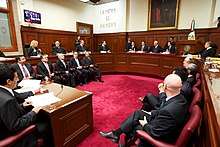
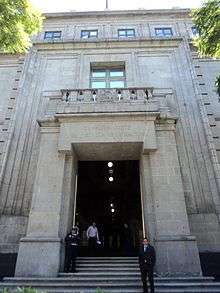
| Title | Name | Birth | Appointer | Affirmation by the Senate | Age at appt. | Elected / Length of service |
|---|---|---|---|---|---|---|
| President | Arturo Zaldívar Lelo de Larrea | 9 August 1959 (age 61) in Querétaro, Querétaro |
Felipe Calderón | 90 | 50 | 1 December 2009 10 years, 8 months |
| Minister | José Fernando Franco González-Salas | 4 December 1950 (age 69) in Mexico City |
Vicente Fox | 94 | 56 | 12 December 2006 13 years, 8 months |
| Minister | Luis María Aguilar Morales | 4 November 1949 (age 70) in Mexico City |
Felipe Calderón | 91 | 60 | 1 December 2009 10 years, 8 months |
| Minister | Jorge Mario Pardo Rebolledo | 1 February 1961 (age 59) in Xalapa, Veracruz |
Felipe Calderón | 91 | 50 | 10 February 2011 9 years, 6 months |
| Minister | Alfredo Gutiérrez Ortiz Mena | 14 October 1969 (age 50) in Cuernavaca, Morelos |
Felipe Calderón | 103 | 41 | 1 December 2012 7 years, 8 months |
| Minister | Alberto Pérez Dayán | 13 December 1960 (age 59) in Mexico City |
Felipe Calderón | 104 | 51 | 3 December 2012 7 years, 8 months |
| Minister | Javier Laynez Potisek | 2 June 1959 (age 61) in Torreón, Coahuila |
Enrique Peña Nieto | 81 | 56 | 10 December 2015 4 years, 8 months |
| Minister | Norma Lucía Piña Hernández | — | Enrique Peña Nieto | 79 | — | 10 December 2015 4 years, 8 months |
| Minister | Juan Luis González Alcántara Carrancá | 19 August 1949 (age 70) in Mexico City |
Andrés Manuel López Obrador | 114 | 69 | 20 December 2018 1 year, 7 months |
| Minister | Yasmín Esquivel Mossa | 15 September 1963 (age 56) in Mexico City |
Andrés Manuel López Obrador | 95 | 55 | 12 March 2019[5] 1 year, 5 months |
| Minister | Margarita Ríos Farjat | — in Monterrey, Nuevo León |
Andrés Manuel López Obrador | 94 | 46 | 5 December 2019 8 months |
Presidents

The following persons were once Presidents of the Supreme Court under the 1917 Constitution:
- 1917–1919: Enrique M. del Río
- 1919–1920: Ernesto Garza Pérez
- 1920–1922: Enrique Moreno Pérez
- 1922–1923: Gustavo A. Vicencio
- 1923–1924: Francisco Modesto Ramírez
- 1924–1925: Gustavo A. Vicencio
- 1925–1927: Manuel Padilla
- 1927–1928: Francisco Díaz Lombardo
- 1928–1929: Jesús Guzmán Vaca
- 1929–1933: Julio García
- 1934: Francisco H. Ruiz
- 1934–1940: Daniel V. Valencia
- 1941–1951: Salvador Urbina
- 1952: Roque Estrada Reynoso
- 1953: Hilario Medina
- 1954: José María Ortiz Tirado
- 1955–1956: Vicente Santos Guajardo
- 1957: Hilario Medina
- 1958: Agapito Pozo Balbás
- 1959–1964: Alfonso Guzmán Neyra
- 1965–1968: Agapito Pozo Balbás
- 1969–1973: Alfonso Guzmán Neyra
- 1974–1975: Euquerio Guerrero López
- 1976: Mario G. Rebolledo Fernández
- 1977–1981: Agustín Téllez Cruces
- 1982: Mario G. Rebolledo Fernández
- 1982–1985: Jorge Iñárritu y Ramírez de Aguilar
- 1986–1990: Carlos del Río Rodríguez
- 1991–1994: Ulises Schmill Ordóñez
- 1995–1999: José Vicente Aguinaco Alemán
- 1999–2002: Genaro David Góngora Pimentel
- 2002–2006: Mariano Azuela Güitrón
- 2007–2010: Guillermo Iberio Ortiz Mayagoitia
- 2011–2014: Juan N. Silva Meza
- 2015–2018: Luis María Aguilar Morales
- 2019–incumbent: Arturo Zaldívar Lelo de Larrea
References
- Article 94 Mexican Constitution
- Galindo, Carmen; Magdalena Galindo (2002). Mexico City Historic Center. Mexico City: Ediciones Nueva Guia. p. 60. ISBN 968-5437-29-7.
- John Ross, CounterPunch, 16 July 2010, In the Basement of Mexican Justice, No One is Innocent Archived 19 July 2010 at the Wayback Machine
- "¿Qué es la Suprema Corte de Justicia de la Nación y dónde se ubica?" (in Spanish). Archived from the original on 28 February 2009. Retrieved 24 March 2009.
- "Yasmín Esquivel Mossa es elegida nueva ministra de la SCJN" [Yasmín Esquivel Mossa is Elected New SCJN Minister]. El Economista (in Spanish). Notimex. 12 March 2019. Retrieved 15 September 2019.
External links
| Wikimedia Commons has media related to Suprema Corte de Justicia de la Nación (México). |
- (in Spanish) Official site
.svg.png)